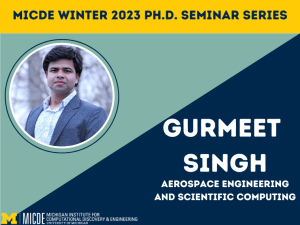Presented By: Michigan Institute for Computational Discovery and Engineering
MICDE Ph.D. Student Seminar: Gurmeet Singh
Gurmeet Singh, PhD Candidate, Aerospace Engineering and Scientific Computing

Topic: Understanding thermomechanical behavior of vitrimers using molecular dynamics simulations
Vitrimers are a special class of polymers that undergo dynamic cross-linking under thermal stimuli. Their ability to exchange covalent bonds can be harnessed to mitigate damage in a composite or to achieve recyclable composites. This work addresses the primary challenge of modeling dynamic cross-linking reactions in vitrimers during thermomechanical loading. Dynamic bond exchange reaction probability change during heating and its effect on dilatometric and mechanical response are simulated in large scale molecular dynamics (MD) simulations. Healing of damage under thermal cycling is computed with mechanical properties predicted before and after self–healing.
Subsequently, the model is used to simulate the creep response of the vitrimer. The results show that the vitrimers demonstrate a secondary creep response on contrary to pure epoxy. The MD simulations are able to probe the interplay between chemical reactions and the loading that results in the healing of the vitrimer under creep. The important feature that explains the difference between epoxies and vitrimers is the orientation of the crosslink bonds with respect to the loading direction. Furthermore, it is found that the free volume that arises from tensile loads is reduced in vitrimers through dynamic bond rearrangement. The bond orientation, however, is preferentially chosen to be normal to the loading axis which ends up decreasing the stiffness along the loading axis, leading to higher strain as compared to epoxies. Over longer timescales, the increased strain leads to faster damage localization in tertiary creep where the largest void grows to a critical volume beyond which healing is no longer possible. Thus, chemistry changes or additives that can prevent the initial realignment of dynamic bonds can be an effective strategy to mitigate creep in vitrimers.
Vitrimers are a special class of polymers that undergo dynamic cross-linking under thermal stimuli. Their ability to exchange covalent bonds can be harnessed to mitigate damage in a composite or to achieve recyclable composites. This work addresses the primary challenge of modeling dynamic cross-linking reactions in vitrimers during thermomechanical loading. Dynamic bond exchange reaction probability change during heating and its effect on dilatometric and mechanical response are simulated in large scale molecular dynamics (MD) simulations. Healing of damage under thermal cycling is computed with mechanical properties predicted before and after self–healing.
Subsequently, the model is used to simulate the creep response of the vitrimer. The results show that the vitrimers demonstrate a secondary creep response on contrary to pure epoxy. The MD simulations are able to probe the interplay between chemical reactions and the loading that results in the healing of the vitrimer under creep. The important feature that explains the difference between epoxies and vitrimers is the orientation of the crosslink bonds with respect to the loading direction. Furthermore, it is found that the free volume that arises from tensile loads is reduced in vitrimers through dynamic bond rearrangement. The bond orientation, however, is preferentially chosen to be normal to the loading axis which ends up decreasing the stiffness along the loading axis, leading to higher strain as compared to epoxies. Over longer timescales, the increased strain leads to faster damage localization in tertiary creep where the largest void grows to a critical volume beyond which healing is no longer possible. Thus, chemistry changes or additives that can prevent the initial realignment of dynamic bonds can be an effective strategy to mitigate creep in vitrimers.